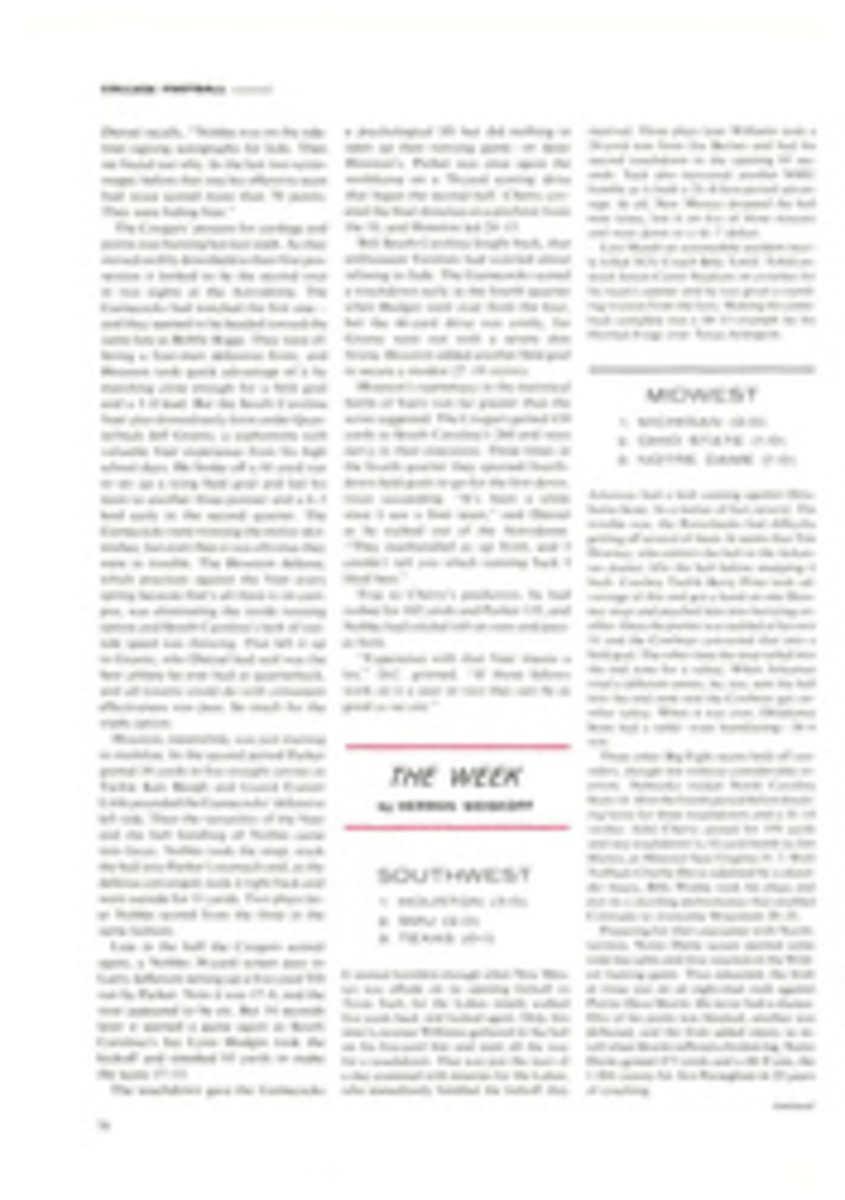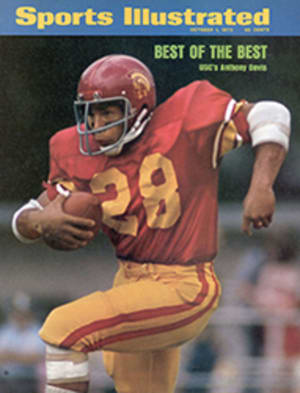
Veer meets Son of Veer
There was so much hee-hawing about what a difference a Veer makes that for a while last week even South Carolina believed it had a chance against Houston. Following a 4-7 season during which a cabal of critics parked a moving van in front of Paul Dietzel's home, the Gamecock coach decided to, O.K., clean house. Out went the old offense and defense and in came seven new assistant coaches from exotic places like Florence State University and Walhalla High School. The veteran team enjoyed renewed vigor, and the rewards were immediate. South Carolina and its new Veer opened with a 41-28 upset of Georgia Tech, the finest moment a Dietzel team has enjoyed in seven aggravating years.
Now Dietzel was taking his Veer offense to the very place it was first used, Houston, and trying to beat the coach who developed it, Bill Yeoman.
"I'd drawn it on paper and practiced it in the spring of 1965," said Yeoman last week. "But I didn't have the guts to go to it until midseason when it looked as if we were all about to be fired."
In the seven complete seasons since, the Cougars have finished in the Top 20 six times, have produced five 1,000-yard runners and have won three total-offense titles and two rushing championships. While defensive coaches sought an honorable peace, offensive coaches came as pilgrims to Yeoman's door. Yeoman discussed the offense in detail and put his play book on the open market for $10 a copy. Since 1969 it has found its way onto more than 1,000 bookshelves.
But as South Carolina was to learn last Friday night in the Astrodome, trying to beat Houston with the Veer is like challenging Betty Crocker to a bake-off. Dietzel admitted he could not match the Cougars' personnel but he felt he had an equalizer that even Yeoman was wary of—enthusiasm. "I don't like those kinds of teams," said the Houston coach, "and South Carolina is sky-high."
While the game would superficially be Veer against Veer, the Houston offense actually is much more complicated than that. South Carolina would use the basic Veer play, quarterback handing off to fullback up the middle, keeping it himself or pitching to a halfback. But Houston was offering much more.
"The success of our offense is no longer just the triple-option play," says Yeoman. "A team must prepare to stop it, but we'll seldom run it more than 20% of the time. What we have is an entire Veer offense that includes draws, counters, screen passes—a lot of things. The triple option no longer has the surprise value it once had, so if a team can cut off those options you need other things to go to."
In Quarterback D.C. Nobles—if you don't believe D.C. is his first name he'll whip out his birth certificate to prove it—Houston has a player perfectly suited to Yeoman's offense. He is quick of hand, strong of arm, fast of foot and blithe of demeanor. Not only that, he is the second best chess player in Lufkin, Texas. The best, he says, is the man who taught him, there being no others. D.C. is further distinguished by his appraisal of Houston's future when it begins competing for the Southwest Conference title in 1976. "The trips won't be as good," he allows, "but the Cougars will see an awful lot of the Cotton Bowl."
Nobles' backfield help is deep and effective and no less confident. There is, for instance, Fullback Leonard Parker, who is built like a guard and runs like a tackle with a bad knee. Unfortunately, he has a bad knee, though he refuses to admit it. And there is Reggie Cherry, who claims there is nothing so difficult about succeeding a long line of Paul Gipsons and Robert Newhouses because what the Veer did for them it can do for him.
"If South Carolina tries to defense us with a four-man front the way they did Georgia Tech, we'll run all over them," said Cherry. "Every back we have will gain 100 yards. You can't leave the inside wide open. I mean, if they got the Veer, they should know that."
Nor would knowledge alone be sufficient. Early in the week a South Carolina scout, noting the Cougars' improvement from a 6-4-1 season of last year, admitted, "Then they had weaknesses we might have taken advantage of, but not now. They're a complete team, and it can get pretty distressing to see their yardage build up on that big Astrodome scoreboard."
South Carolina had another problem: it could not get a good line on the Houston players. The Cougars went only one strong half in their opening win over Rice, and an attempt to scout their final intrasquad game last spring had been even less telling. "When we got there," Dietzel recalls, "Nobles was on the sidelines signing autographs for kids. Then we found out why. In the last two scrimmages before that one his offensive team had twice scored more than 70 points. They were hiding him."
The Cougars' passion for yardage and points was burning hot last week. As they moved swiftly downfield in their first possession it looked to be the second rout in two nights at the Astrodome. The Gamecocks had watched the first one—and they seemed to be headed toward the same fate as Bobby Riggs. They were offering a four-man defensive front, and Houston took quick advantage of it by marching close enough for a field goal and a 3-0 lead. But the South Carolina Veer also showed early form under Quarterback Jeff Grantz, a sophomore with valuable Veer experience from his high school days. He broke off a 41-yard run to set up a tying field goal and led his team to another three-pointer and a 6-3 lead early in the second quarter. The Gamecocks were winning the minor skirmishes, but even then it was obvious they were in trouble. The Houston defense, which practices against the Veer every spring because that's all there is on campus, was eliminating the inside running option and South Carolina's lack of outside speed was showing. That left it up to Grantz, who Dietzel had said was the best athlete he ever had at quarterback, and all Grantz could do with consistent effectiveness was pass. So much for the triple option.
Houston, meanwhile, was just starting to mobilize. In the second period Parker gained 39 yards in five straight carries as Tackle Ken Baugh and Guard Everett Little pounded the Gamecocks' defensive left side. Then the versatility of the Veer and the ball handling of Nobles came into focus. Nobles took the snap, stuck the ball into Parker's stomach and, as the defense converged, took it right back and went outside for 11 yards. Two plays later Nobles scored from the three in the same fashion.
Late in the half the Cougars scored again, a Nobles 36-yard screen pass to Larry Jefferson setting up a five-yard TD run by Parker. Now it was 17-6, and the rout appeared to be on. But 14 seconds later it seemed a game again as South Carolina's Jay Lynn Hodgin took the kickoff and streaked 93 yards to make the score 17-13.
The touchdown gave the Gamecocks a psychological lift but did nothing to open up their running game—or deter Houston's. Parker was once again the workhorse on a 70-yard scoring drive that began the second half. Cherry covered the final distance on a pitchout from the 10, and Houston led 24-13.
Still South Carolina fought back, that enthusiasm Yeoman had worried about refusing to fade. The Gamecocks scored a touchdown early in the fourth quarter when Hodgin went over from the four, but the 46-yard drive was costly, for Grantz went out with a severe shin bruise. Houston added another field goal to secure a modest 27-19 victory.
Houston's supremacy in the statistical battle of Veers was far greater than the score suggested. The Cougars gained 430 yards to South Carolina's 260 and were nervy in their execution. Three times in the fourth quarter they spurned fourth-down field goals to go for the first down, twice succeeding. "It's been a while since I saw a finer team," said Dietzel as he walked out of the Astrodome. "They manhandled us up front, and I couldn't tell you which running back I liked best."
True to Cherry's prediction, he had rushed for 102 yards and Parker 135, and Nobles had totaled 145 on runs and passes both.
"Experience with that Veer means a lot," D.C. grinned. "If those fellows work on it a year or two they can be as good as we are."
PHOTO
OPTION ONE: NOBLES TO HIS FULLBACK

